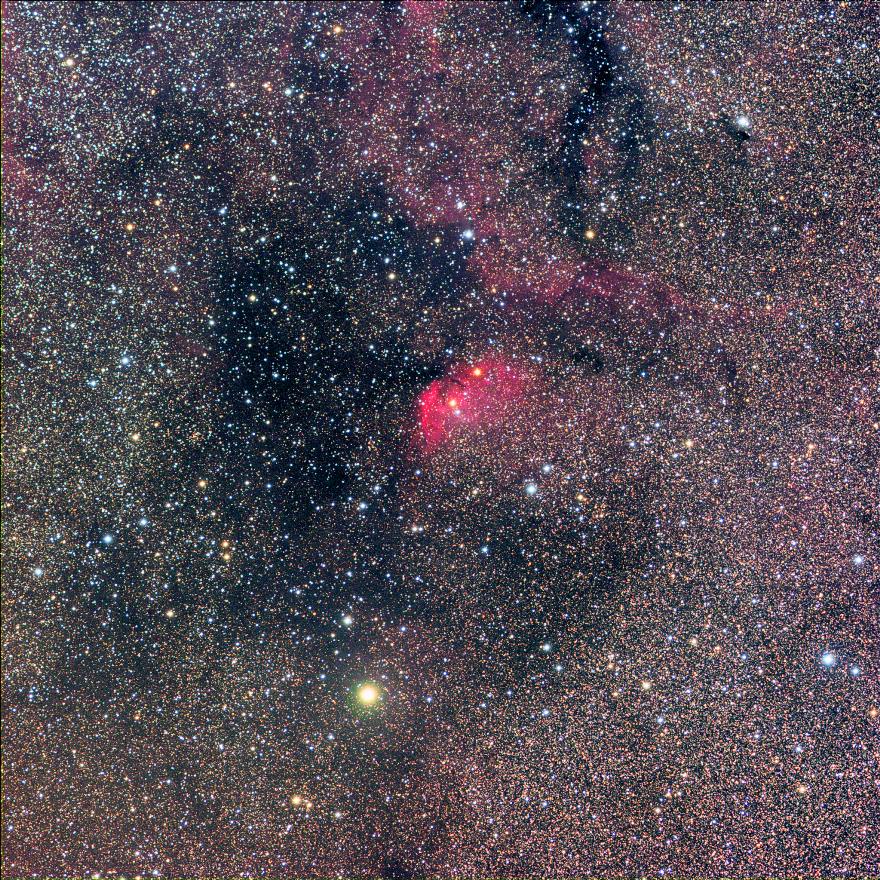Hi everyone, and thanks to Owlice for posting my image here.
I have been asked to provide some thoughts on my image 'The Visible Universe - a journey from 100 km to 12.4 billion light years'
This is a montage of images I have taken from my backyard observatory in Auckland, New Zealand during the years 2005 to 2010 with a 10 inch Newtonian f/5 telescope on a Losmandy G-11 equatorial mount and a modified webcam (Philips ToUCam Pro with Steve chambers' modification for long exposures).
My goal with this project was to illustrate the diversity and enormity of our visible Universe, in a simple yet educational way. I initially wanted something to decorate my observatory wall and I was thinking of somehow making a montage of my images to date. Since I have always liked Solar System models and textbooks with astronomical objects drawn to scale etc. I decided to arrange some of my images according to the subjects' distance from Earth to visualize the scale of the Universe while still trying to maintain simplicity and a good flow in the presentation.
In choosing the images I have tried to include both some well known objects and some more unusual ones that are rarely imaged by amateurs - really something of all types and colors and shapes. It was important to me that the final result conveyed both the enormous scale as well as the diversity of objects we as amateurs are actually able to see with even very modest telescopes and cameras.
Lately I have focused on imaging some of the more obscure deep sky objects and that enabled me to include images of both very distant quasars and galaxy clusters and even a gravitational lens! This brought the limit of the scale out to 12.4 billion light years, almost to the edge of the entire visible Universe which is quite impressive for such basic equipment as a webcam.
A bit of background information about a few of the more unusual objects:
Eta Carinae
Inserted onto the Eta Carinae image is a high resolution image of the Homunculus Nebula which I took with a 5x Televue Powermate and lots of very short exposures. This is as far as I know the highest resolution image of the Homunculus Nebula taken by an amateur. I took the image to see if any radial expansion was visible when comparing with images from professional observatories taken years earlier, and indeed it is very evident. Further details and a full size image can be found here:
http://www.pbase.com/rolfolsen/image/123574588/original
Messier 87 - Giant galaxy with jet
This is a luminous jet emerging from the center of giant elliptical galaxy M87 (full size image here:
http://www.pbase.com/rolfolsen/image/123520553/original). The visible features of the jet corresponds very well with the Hubble image. This is as far as I know also the highest resolution image of this jet taken by an amateur. The image was acquired using many stacked short exposures, although not as short as for the Homunculus Nebula.
The light we see is produced by electrons twisting along magnetic field lines in the jet, a process known as synchrotron radiation, which gives the jet its bluish tint. This contrasts rather nicely with the reddish glow from the combined light of billions of aging stars in the galaxy itself.
The Cartwheel Galaxy
I have always had a fascination with this particular galaxy. I wasn't sure if my webcam could pick up any decent details in it, but over two nights in October and November 2005 I collected enough data to produce a detailed color image which nicely showed off the features of this peculiar galaxy. Visible is an impressive ring-like structure 100,000 light years across, illuminated by young blue super giants. This shape is the result of the gravitational disruption caused by a small intruder galaxy passing directly through the larger one, compressing the interstellar gas and dust, and causing a wave of star formation to move out from the impact point like a ripple across the surface of a pond.
The full size image can be seen here:
http://www.pbase.com/rolfolsen/image/123574932/original
Gravitationally lensed quasar HE1104-1805
This gravitationally lensed quasar consist of two images of the same quasar, with magnitudes of 16.70 and 18.64 respectively and separated by 3.195 arc seconds. The lensing galaxy itself is very faint but has been imaged by Hubble Space Telescope and lies closest to the A component, with an angular separation of 1.15 arc seconds.
A gravitational lens is formed when the light from a very distant bright source, such as a quasar, is bent around a massive object, such as galaxy or a cluster of galaxies, between the source object and the observer. The process is known as gravitational lensing, and is one of the predictions of Einstein's general theory of relativity.
Full image of this quasar is available here:
http://www.pbase.com/rolfolsen/image/123520551/original
High redshift quasar Q1451-15
This quasar is the most remote object I have accomplished to catch with my telescope. With a red shift of 4.762 this object is located 91% of the way to the edge of the visible Universe, or over 12 billion light years. It is rather mind blowing to imagine that the photons that landed on my little CCD chip started their journey many billions of years before even the Solar System existed, and the Universe itself was only a fraction of its current size.
A full image of this quasar is available here:
http://www.pbase.com/rolfolsen/image/123574590/original
Thank you for letting me tell the story behind my image and I hope this presentation can serve as inspiration for people around the world to look up and appreciate the immense scale and many wonders of our Universe.
With regards,
Rolf Olsen







